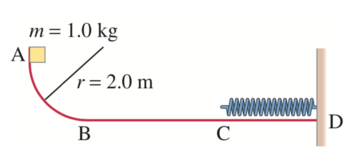Problem
Consider the track shown. The section AB is one quadrant of a circle of radius 2.0 m and is frictionless. B to C is a horizontal span 3.0 m long with a coefficient of kinetic friction  = 0.25. The section CD under the spring is frictionless. A block of mass 1.0 kg is released from rest at A. After sliding on the track, it compresses the spring by 0.20 m. Determine:
= 0.25. The section CD under the spring is frictionless. A block of mass 1.0 kg is released from rest at A. After sliding on the track, it compresses the spring by 0.20 m. Determine:
(a) the velocity of the block at point B;
(b) the thermal energy produced as the block slides from B to C;
(c) the velocity of the block at point C;
(d) the stiffness constant  for the spring.
for the spring.
Solution
(a)
Use conservation of energy to equate the potential energy at the top of the circular track to the kinetic energy at the bottom of the circular track. Take the bottom of the track to the be 0 level for gravitational potential energy.



(b)
The thermal energy produced is the opposite of the work done by the friction force. In this situation, the force of friction is the weight of the object times the coefficient of kinetic friction.




(c)
The work done by friction is the change in kinetic energy of the block as it moves from point B to point C.



(d)
Use conservation of energy to equate the kinetic energy when the block just contacts the spring with the potential energy when the spring is fully compressed and the block has no speed. There is no friction on the block while compressing the spring.






















